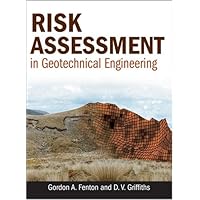
Average Reviews:

(More customer reviews)Two years ago when I started my masters in structural engineering, I had to learn about random field theory. The books that I found, considered the "must reads" for random field theory, might as well have been in Chinese (I don't understand Chinese - just for the record). It was extremely painful and frustrating trying to understand the completely not clear or easy to understand concepts - as they were presented in those books. Upon searching the internet, I found some papers written by Gordon Fenton. His description of random field theory and his work in general, was like an oasis in the desert. This is one very rare person who can explain complicated concepts so that they are easy to understand and apply. So when I found out he was publishing a book, I thought, this is a must have. And I haven't been disappointed. The first section on probability theory is without a doubt, the best explanation of the theory I have seen, with simple examples to help me concrete my understanding of the theory being presented. Therefore, this is the first textbook that I would recommend for people trying to understand the concepts of probability theory. Similarly, all other sections in the book are equally easy to understand and can make even me look intelligent - as he enables me to really understand the concepts being presented, because of his fantastic ability to communicate ' I like in particular, how he explains the practical reasons for why the theory can be simplified or assumptions can be made. Most boffin writers of textbooks don't explain "the obvious" which is not so obvious to the novice person reading their books. Sometimes I think that they don't realise that not everybody has done the mathematics degree required to understand some of the intricacies, which if not clearly explained, can stump the reader for days until they find out why they have assumed this or that. That's where Gordon Fenton is a real a gem. He doesn't leave you scratching your head, scrambling for other textbooks to fill in the gaps before you can continue with his explanations. So I highly recommend this book to anybody trying to understand probability theory, random field theory, estimation, reliability, Monte Carlo simulation and all other topics he covers in his book.
Click Here to see more reviews about: Risk Assessment in Geotechnical Engineering
NEW PROBABILISTIC APPROACHES FOR REALISTIC RISK ASSESSMENT IN GEOTECHNICAL ENGINEERING.
This text presents a thorough examination of the theories and methodologies available for risk assessment in geotechnical engineering, spanning the full range from established single-variable and "first order" methods to the most recent, advanced numerical developments. In response to the growing application of LRFD methodologies in geotechnical design, coupled with increased demand for risk assessments from clients ranging from regulatory agencies to insurance companies, authors Fenton and Griffiths have introduced an innovative reliability-based risk assessment method, the Random Finite Element Method (RFEM). The authors have spent more than fifteen years developing this statistically based method for modeling the real spatial variability of soils and rocks. As demonstrated in the book, RFEM performs better in real-world applications than traditional risk assessment tools that do not properly account for the spatial variability of geomaterials.
This text is divided into two parts:
Part One, Theory, explains the theory underlying risk assessment methods in geotechnical engineering. This part's seven chapters feature more than 100 worked examples, enabling you to develop a detailed understanding of the methods.
Part Two, Practice, demonstrates how to use advanced probabilistic tools for several classical geotechnical engineering applications. Working with the RFEM, the authors show how to assess risk in problems familiar to all geotechnical engineers.
All the programs used for the geotechnical applications discussed in Part Two may be downloaded from the authors' Web site at www.engmath.dal.ca/rfem/ at no charge, enabling you to duplicate the authors' results and experiment with your own data. In short, you get all the theory and practical guidance you need to apply the most advanced probabilistic approaches for managing uncertainty in geotechnical design.
Click here for more information about Risk Assessment in Geotechnical Engineering



















